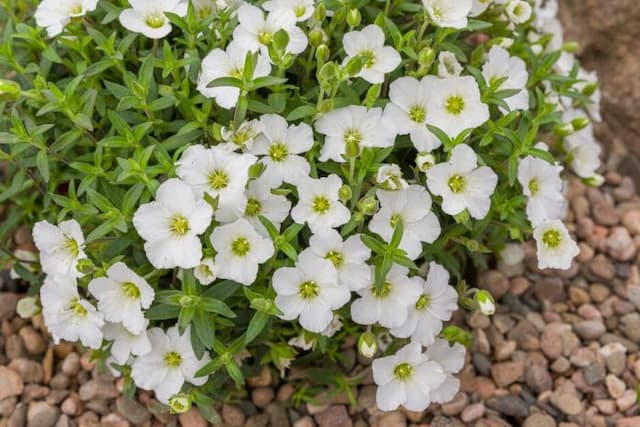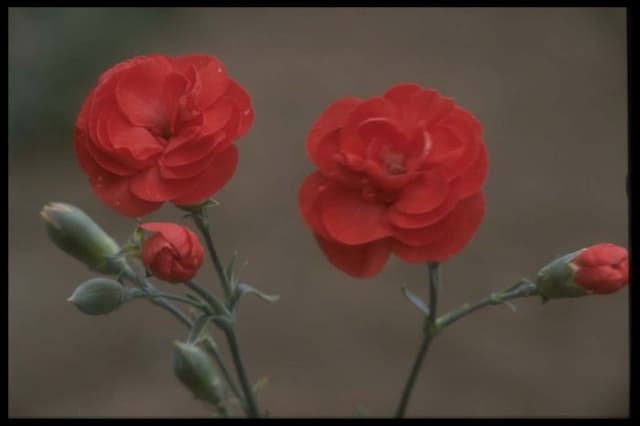Sweet William Dianthus (Allwoodii Group) 'Doris' pre-1954 (p)

ABOUT
The Dianthus 'Doris' is a charming plant with a classic and delightful appeal. It is distinguished by its beautiful pink flowers that possess a subtle yet sweet fragrance that enhances the ambiance of any garden. Each flower showcases a delicate, soft pink hue with a lovely, deeper pink or sometimes light red eye at the center, creating a striking contrast against the blossom's soft palette. The petals are frilly with a slight serration, giving them an intricate and slightly ruffled look that adds to their charm. These blooms are prolific and arrange themselves densely atop slender, sturdy stems that rise above the plant's base. The foliage of Dianthus 'Doris' is composed of slender, linear leaves with a blue-green color. The leaves exude a grassy appearance and are often seen as a lush, compact mound which offers a perfect backdrop for the vivid flowers. Collectively, the plant forms a neat, dense clump, showcasing the vibrant bursts of pink from its bountiful blooms which can last from late spring until the beginning of autumn, providing an extended display of color in any outdoor space. The plant has a tidy, evergreen habit that helps to suppress weeds and can be an excellent candidate for borders, potted displays, or as part of a rockery landscape.
About this plant
 Names
NamesFamily
Caryophyllaceae
Synonyms
Doris Pinks, Allwood's Pinks
Common names
Dianthus 'Doris'.
 Toxicity
ToxicityTo humans
Pinks (a common name for Dianthus) are not known to be toxic to humans. However, as with any plant material, individual sensitivities can vary, and ingesting significant amounts could potentially result in gastrointestinal discomfort.
To pets
Pinks are not typically considered toxic to pets. However, gastrointestinal upset could occur if a pet were to ingest a large amount of the plant. It's always best to monitor pets around plants and discourage them from eating plant material to prevent any potential digestive issues.
 Characteristics
CharacteristicsLife cycle
Perennials
Foliage type
Evergreen
Color of leaves
Blue-green
Flower color
Pink
Height
1 foot 2 inches (35 cm)
Spread
1 foot (30 cm)
Plant type
Herb
Hardiness zones
5
Native area
Europe
Benefits
 General Benefits
General Benefits- Attracts Pollinators: The Dianthus 'Doris' boasts vibrant flowers which are attractive to bees and butterflies, promoting biodiversity in the garden.
- Easy Maintenance: This plant variant is low maintenance, making it a good choice for gardeners of all skill levels.
- Durability: It is known to be hardy in a variety of climates and resistant to many plant diseases, ensuring longevity in the garden.
- Long Blooming Season: The Dianthus 'Doris' typically has a long flowering period, providing a display of color throughout the growing season.
- Scented Flowers: The blooms emit a pleasant fragrance, which can add an aromatic element to gardens and living spaces.
- Groundcover: Its growth habit makes it useful for covering bare patches in the garden, suppressing weeds, and reducing soil erosion.
- Edible Petals: The petals are edible and can be used in culinary preparations for garnishing or as an ingredient in salads.
- Landscape Versatility: It is suitable for a variety of landscape uses including borders, rock gardens, and containers.
- Aesthetic Appeal: With its densely packed, colorful flowers and attractive foliage, it adds visual interest and aesthetic value to garden settings.
- Seasonal Cut Flowers: The flowers can be cut and used in floral arrangements, adding a personal touch to indoor décor.
 Medical Properties
Medical PropertiesThis plant is not used for medical purposes.
 Air-purifying Qualities
Air-purifying QualitiesThis plant is not specifically known for air purifying qualities.
 Other Uses
Other Uses- Dianthus can be used as a natural fabric dye, producing a range of soft pinks and purples depending on the mordant used.
- The flowers are edible and can be used to add color and a mild spicy flavor to salads or as a garnish for dishes.
- Dried Dianthus petals can be used in potpourri to impart fragrance to a room.
- The essential oils extracted from Dianthus are sometimes employed in perfumery for their rich, spicy floral scent.
- Dianthus, when planted strategically in the garden, can serve as a pest repellent because certain insects dislike their fragrance.
- The brightly colored blooms can be pressed and included in craft projects such as cards, bookmarks, or framed botanical art.
- These plants can be used as natural indicators of soil pH, as their growth and bloom quality may change with soil conditions.
- They can serve as companion plants, helping to support the growth of vegetables by attracting beneficial insects or deterring pests.
- When Dianthus are in bloom, they can be utilized as living decorations for outdoor events and celebrations.
- Hobbyists may use the petals for making natural inks for calligraphy or drawing.
Interesting Facts
 Feng Shui
Feng ShuiThe Dianthus, commonly known as pinks or carnations, can be used in Feng Shui to bring positive energy into the home, particularly in the relationship area or the southwest sector of your space. Their vibrant energy and fragrance are said to promote love and healing.
 Zodiac Sign Compitability
Zodiac Sign CompitabilityThe Dianthus is not used in astrology practice.
 Plant Symbolism
Plant Symbolism- Divine Love: The name "Dianthus" comes from the Greek words "dios," meaning divine, and "anthos," meaning flower, symbolizing divine or heavenly love.
- Boldness: Dianthuses have a history of being used to convey boldness or a daring spirit, perhaps due to their bold colors and patterns.
- Passion: Often associated with affection and strong emotions, the vibrant hues of the dianthus flower signify passion.
- Pure Affection: The dianthus flower, particularly in lighter shades, is also a symbol of pure and platonic love.
- Admiration: Gifting these flowers can express admiration for someone's ingenuity or dedication.
- Longevity: Due to their long-lasting nature when cut, dianthus flowers represent a wish for a long and happy life.
 Water
WaterPinks, including 'Doris', prefer well-drained soil and should not be left too damp, so it's crucial to water them deeply but infrequently. Watering thoroughly once a week is a good practice, allowing the soil to dry out somewhat between waterings. During the hotter summer months, you might need to water twice a week, especially if the weather is particularly dry or windy. Ensure that each watering provides enough moisture to penetrate the top six to eight inches of soil. As a general guide, use about one gallon of water per square yard each week, adjusting as necessary for weather conditions.
 Light
LightPinks, as Dianthus 'Doris' is commonly known, thrive in full sun where they can receive at least six hours of direct sunlight a day. Place them in a spot where they will be exposed to bright light to ensure optimum growth and blooming. If grown indoors, a south-facing window is ideal to provide the light intensity they require.
 Temperature
TemperaturePinks are tolerant of a range of temperatures but grow best when daytime temperatures are around 60-75°F and night temperatures don't drop below 50°F. They can survive down to freezing temperatures for short periods, but sustained cold below 32°F can damage or kill the plant. Their ideal growing conditions are in moderate climates, not too hot or too cold.
 Pruning
PruningPinks should be pruned to promote bushy growth, remove spent flowers, and maintain a neat appearance. Deadheading, or removing the faded flowers, encourages further blooming. After the first flush of bloom, cut back the flowering stems by one-half to encourage a second bloom in the fall. Pruning is best done just after the peak flowering period has passed.
 Cleaning
CleaningAs needed
 Soil
SoilPinks (Dianthus) thrive in well-draining, loamy soil with a slightly alkaline pH of 6.5 to 7.5. A good soil mix for Pinks would be one part garden soil, one part compost, and one part perlite or sand to ensure proper drainage. Regular feeding with a balanced fertilizer is recommended during the growing season.
 Repotting
RepottingPinks (Dianthus) do not require frequent repotting and can often be left in the same pot for several years. If the plant becomes root-bound or the soil is exhausted, repotting can be done in the spring every 2-3 years using fresh, well-draining soil mix.
 Humidity & Misting
Humidity & MistingPinks (Dianthus) prefer moderate humidity levels; however, they are quite adaptable and can tolerate a range from low to high humidity. Ensure good air circulation around the plants to minimize the risk of foliar diseases, particularly if humidity is high.
 Suitable locations
Suitable locationsIndoor
Ensure bright light, good air flow, and dry conditions.
Outdoor
Full sun, well-drained soil, protect from wet winters.
Hardiness zone
4-9 USDA
 Life cycle
Life cycleDianthus 'Doris' begins its life cycle when the seeds germinate, typically in early spring, given adequate warmth and moisture. The seedlings emerge and establish themselves, forming a rosette of leaves at ground level. Flowering stems elongate from the rosette in late spring to summer, showcasing the plant's fragrant pink flowers with frilled edges. After pollination, often by insects attracted to the blooms, seeds develop and are released when the flowers fade, completing the reproductive cycle. If conditions are unfavorable for seed germination, this perennial plant can survive through its root system, re-sprouting the following year. Over time, Dianthus 'Doris' can form dense clumps that may require division every few years to maintain plant vigor and flower production.
 Propogation
PropogationPropogation time
Spring-summer
The most popular method of propagation for the Dianthus 'Doris', also known as Pink 'Doris', is by cuttings. This is typically done in late spring or early summer when the plant's growth is most vigorous. Gardeners should select healthy, non-flowering stems and cut a 3 to 4-inch (approximately 7.5 to 10 centimeters) length just below a node. The lower leaves are removed, and the cutting is dipped in rooting hormone before being inserted into a well-draining soil mix. It's important to keep the soil moist but not waterlogged and to provide a good balance of light and warmth to encourage rooting. Roots usually develop within a few weeks, after which the new plant can be gradually acclimatized to outdoor conditions before planting out.


![Pink [Tequila Sunrise]](/_next/image?url=https%3A%2F%2Fplants-admin.emdemapps.com%2Fimages%2Fplants%2F%2Fimages%2F604b5d995d06e.png&w=640&q=75)






